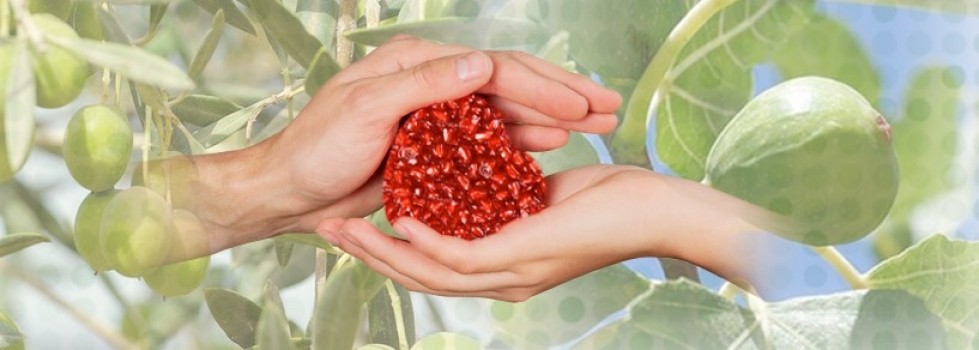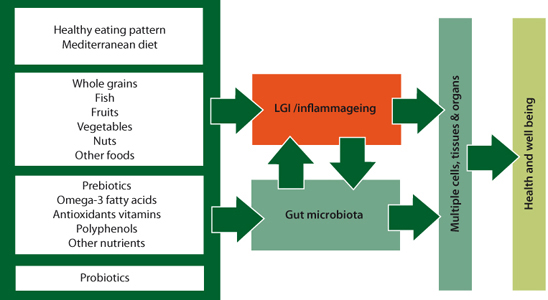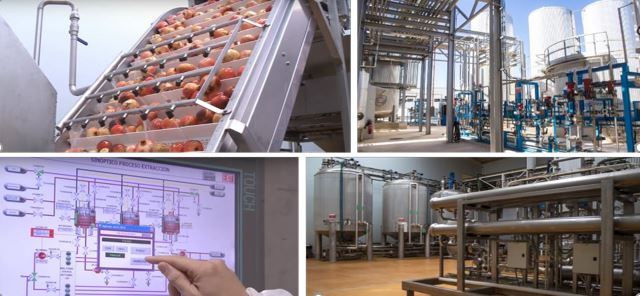Promotional Features
Extracting the health-promoting properties of Mediterranean diet botanicals
Higher intake of plant-based foods promotes health. Euromed technologies transform Mediterranean botanicals into standardized extracts, complementing the Mediterranean diet health benefits
The Mediterranean diet
The traditional Mediterranean diet (MD) is characterized by a large consumption of vegetables and fruits, olive oil, whole grains, legumes and nuts, moderate intake of meat, especially as fish, and red wine, as well as low consumption of processed sugars and fatty foods of animal origin.
Since the Seven Countries study (1), evidence suggests that the MD, as a whole and in the context of an appropriate lifestyle, contributes to reducing cardio-metabolic diseases risk factors and preventing several age-related diseases (ARDs) (2,3).
The complex process of aging is the major risk factor for cardiovascular disease (CVD) and relates to endothelial dysfunction (ED), which increases CVD risk. High blood pressure (BP), hyperglycemia and diabetes, tend also to increase with age, with high risk of developing fatal ARDs (4). The elderly population is forecast to increase and, by extension, so is the incidence of ARDs. Prevention and reduction of modifiable risk factors are of paramount importance.
Fruits and vegetables
Genetic make-up, eating patterns and exercise are key in healthy aging. Unfortunately, imbalanced diet and poor lifestyle habits have emerged as major contributors to early mortality (5). Plant-based foods, as in the MD, promote better health: regular consumption of nuts, fruit and vegetables (up to 10 servings per day), and olive oil (up to 5 tablespoons per day) are recommended to support longevity, cognitive functions, lower risk of CVD, diabetes and obesity (6-9).
Since vegetables, fruits, nuts, and olive oil are rich in phytochemicals, particularly the polyphenols, their properties likely contribute to the benefits of the MD. Research indicates that polyphenols play a major role in the protective effects conferred by plant-derived foods and beverages (10).
High doses of polyphenols are essential to achieve significant health effects, but their inconsistent bioavailability in different commercial products, and food processing (11), confound the estimation of the amounts of food sources required. Modern fast-paced societies, drawn to calories-rich, prepared and packaged foods, find it challenging to eat the daily consumption of recommended daily servings of olive oil, fresh fruits and vegetables. While not substituting for a healthy diet and lifestyle, identification, extraction and investigation of the most promising MD phytochemical compounds, and their preparation in standardized and practical formats, may offer significant health benefits.
ARDs and inflammaging
The multifactorial etiology of ARDs has given rise to the concept of ‘inflammaging’, referring to long-term mild chronic inflammation associated with aging. This ‘holistic biomarker’ of biological aging is a hallmark of ARD susceptibility and a shared risk factor for many ARDs. Studies link aging to gut microbiota: persistent dysbiosis has a central role in inflammaging, as inflammatory compounds released by the altered gut compromise the integrity of the intestinal barrier (12). Senescent (aging) cells are characterized by the production of inflammatory mediators, likely accelerating aging and onset of ARDs (13). Healthy eating patterns such as the MD are associated with lower concentrations of inflammatory mediators; conversely a Western-style diet is associated with higher concentrations (14,15).
Scheme linking diets and specific dietary components to health and well-being through modulation of gut microbiota and low grade inflammation (LGI).
Adapted and modified from: P.C. Calder et al. Ageing Research Reviews 40 (210/) 95-119
Polyphenols and inflammaging
Many dietary compounds, including polyphenols, can modulate the senescence process. Polyphenols possess antioxidant and anti-inflammatory activity, and have diverse effects on the mechanisms underlying gut health, aging, diabetes and CVD. In-vitro and in-vivo studies have suggested that phenolic compounds from olives and pomegranates protect cells from senescence by modulating the activation of the major pro-inflammatory pathways, in addition to other biological activities (16). Euromed phytopharmacology expertise, and more than seven years in R&D, led to the development of natural extracts of pomegranates and olives: Pomanox and Mediteanox. Their patented manufacturing process is based on a proprietary ecological technology, the Pure-Hydro Process, avoiding chemical solvents, and protecting the environment.
Olive phenolics
Olive oil is accountable for most of the MD’s beneficial effects. Olive (Olea europaea L.) anti-inflammatory phenolic compounds inhibit LDL oxidation, a process related to the development of atherosclerosis (17). Olive oil consumption, specifically the extra-virgin quality (EVOO), is associated with longevity, neuroprotection, and decreased risk of developing chronic degenerative disorders (18). The European Food Safety Authority (EFSA) has confirmed that a cause and effect relationship can be established between the consumption of olive oil phenolics (hydroxytyrosol and derivatives) and protection of LDL particles from oxidative damage, leading it to state that “olive oil polyphenols contribute to the protection of blood lipids from oxidative stress” (19).
However, the presence of hydroxytyrosol (HT) in EVOO is extremely variable, between 0.5 to 10 mg/kg. For primary and secondary prevention, long term intake of high-quality HT standardized olive extracts should be considered, especially when the individual is unable to follow a MD. One option is Mediteanox, Euromed olive fruit extract, standardized to natural HT and manufactured with the Pure-Hydro Process.
Mediteanox is 100% water soluble and available in HT concentrations up to 40%, for various product applications (powder and liquid). It is supported by a safety package, preclinical data and intervention studies in humans (pending publication) that indicate blood circulation improvement, plus reduction of cholesterol and inflammatory markers. Preliminary results from a 20-weeks clinical trial suggest synergism with Pomanox in improving endothelial function and reducing LDL cholesterol oxidation (20). The production process and health applications in functional foods, oils and dietary supplements, are patent-protected.
Euromed´s portfolio includes Proliva, a clinically tested, high potency 20% HT standardized extract, (17).
While the food supplement format is practical, many consumers prefer the traditional oil format. For the CV health benefits, EFSA established a daily intake at least of 5 mg of HT or derivatives, in 20 ml of olive oil (19), and up to five tablespoons may be recommended, corresponding to around 700 calories. Secret to Live, Euromed EVOO containing 150% more HT than standard EVOO and supported by one human study, fits this demand, with less calories.
Microbiome-friendly pomegranate polyphenols
Urolithins are gut microbiota-derived metabolites of ellagitannins. Ellagitannin-rich foods mainly include pomegranates, strawberries and walnuts. Urolithins A and B are the main derived metabolites, which attenuate inflammation by inhibiting activation of inflammatory pathways, and are emerging as powerful botanical inflammaging quenchers (21).
Punicalagins are the main phenolic compounds in pomegranate (Punica granatum L.) husk. Taken orally, they release ellagic acid that partially passes to the plasma and reaches the colon where it is metabolized by the gut microbiota to yield urolithins A and B (22). Pomanox is a fully characterized pomegranate whole fresh fruit extract, with a phenolic profile comparable to that of juice, but without the calories. Concentrated liquid or powder formats, are standardized for punicalagins content (up to 30%). It originates from quality controlled, ecological cultivars in Spain, is obtained through the Pure-Hydro Process - is available as certified organic - and supported by toxicological, pre-clinical and clinical studies.
Pomanox supports a healthy inflammatory response (23) and has many evidence-based health applications (20, 24-30), including anti-oxidant, sport and endurance, prebiotic, mood, cognition, satiety, hormonal and, mostly, cardiovascular support. Normalization of BP has been reported in five published academic trials (26-30). High BP is the greatest contributor to CVD and one of the most common CVD risk factors. Any safe approach that can efficaciously reduce BP has important values. A recent meta-analysis confirms the benefits of pomegranate juice consumption on BP (31). Pomanox’s improvement of the endothelium, the inner layer of the arteries, is the key trigger: activating the Akt/endothelial nitric oxide-synthase pathway and counteracting vascular inflammation and oxidative damage (27). Evaluation of gene expression of markers associated with CVD after consumption of Pomanox, provided useful indications (study pending publication).
Identification of novel health properties of phytochemical: abscisic acid (ABA)
While vitamins and phenolics have long been recognized as beneficial compounds in fruits and vegetables, awareness of the role of terpenes has only emerged recently. Terpenes are numerous and structurally diverse phytochemicals; some of them are considered to be primary rather than secondary plant metabolites, due to their important role in stress physiology. ABA is a terpenoid plant hormone present in various fruits and vegetables and also released endogenously by some mammal cells.
ABA has recently shown anti-inflammatory and immunoregulatory properties in preclinical and clinical models of diabetes and inflammation and other promising health applications (32-39). The metabolic properties of ABA are of particular interest, considering the health impact of hyperglycemia: ABA can induce precise metabolic and signaling changes that improve glucose and insulin tolerance and enhance insulin efficiency suggesting an adaptogen glycemic homeostasis, while reducing adipose cells inflammation. According to a recent US dietary survey, 92% of people have inadequate intake of fruits and vegetables (40), therefore they might lack ABA.
Figs (Ficus carica L.) contain one of the highest concentrations of ABA in nature. ABAlife is the first fruit extract, by a patent pending Euromed process, that standardizes liquid and powder formats for various strengths of natural ABA from whole fig fruits. Its administration (100-200 mg) to healthy volunteers (41) lowered blood glucose and insulin and significantly reduced glycemic and insulinemic indexes, between 30 and 120 minutes post-prandial (glucose). Further studies are in progress.
Extracting bioactive compounds from botanicals
Phytochemical content depends on many controllable preharvest and postharvest factors.
By controlling them, unique products are generated, suitable for reliable and consistent health applications and replicable research studies. Novel approaches for the discovery of active phytochemicals from the MD are emerging, to identify well chemically characterized extracts, their metabolites and their biological activity in -vivo (42). Decades of botanical expertise, innovation, and state of the art eco-friendly technologies such as Pure-Hydro Process give Euromed fruit extracts, as with all Euromed plant extracts, guaranteed identity, traceability, consistent evidence-based potency and sustainability.
Andrea Zangara, Scientific Marketing Manager at Euromed, will expand on these topics in a presentation at SupplySide West in Las Vegas taking place at Conference Room – Mariners B. Thursday 11/08/2018 at 4pm.
References
- Keys A. American Heart Association Monograph (1970) Number 29; American Heart Association: New York, NY, USA
- Zangara A & Zangara A (2017) La Moderna Alimentazione Mediterranea.Padova, Piccin
- Rosato V, et al. Eur J Nutr. 2017 Nov 25 [Epub ahead of print]
- Singh GM, et al. Circulation. 2012, 125:2204-2211
- World Health Organization (2015) Noncommunicable diseases. Fact sheet. World Health Organisation,Geneva
- Wang X, et al. BMJ. 2014, 349:g4490
- Boeing H, et al. Eur J Nutr. 2012, 51(6):637–663
- Esposito K, et al. JAMA. 2004; 292(12):1440-6
- Estruch R, et al. Ann Intern Med. 2006; 145(1):1-11
- Scalbert A, et al. Crit Rev Food Sci Nutr. 2005; 45: 287–306
- Rothwell JA, et al. Mol Nutr Food Res. 2015; 59(1):160-70
- Franceschi C, et al. Nat Rev Endocrinol. 2018 [Epub ahead of print]
- Van Deursen JM. Nature, 2014; 509(7501), 439–446
- Calder PC, Ageing Res Rev. 2017;40:95-119
- Santoro A, Mech Ageing Dev. 2014;136-137:3-13
- Gurău F, et al. Ageing Res Rev. 2018;46:14-31
- Pais P, Villar A, & Rull S. Drugs in R&D. 2016; 16(4), 355–368
- Santangelo C, et al. Endocr Metab Immune Disord Drug Targets. 2018;18(1):36-50
- EFSA J. 2011;9:2033
- R. Quirós Fernández et al. Libro de Comunicaciones FESNAD 2015. Communication Congress nº207
- Xu J, et al. J. Agric. Food Chem. 2018; 66, 571–580
- Espín J, et al. eCAM, 2013, 270418
- Martín-Sánchez F, et al. Cell Death Differ. 2016;23(7):1219-31
- Stockton A, et al. Annals of Nutrition and Metabolism. 2013;63:1193
- Dujaili AI, et al. Endocrine Abstracts. 2012; 28 P313
- Stockton A, et al. EC Nutrition 2.4. (2015): 396-411
- Vilahur G, et al. Rev Esp Cardiol (Engl Ed). 2015;68(3):216-25
- Tsang C, et al. Journal of Nutritional Science (2012), vol. 1, e9, page 1-9
- Dujaili AI, et al. EC Nutrition 4.6 (2016): 982-995
- Stockton A, et al. J Nutr Sci. 2017; 6: e39
- Sahebkar A, et al. Pharmacol Res. 2017;115:149-161
- Bassaganya-Riera J, et al. Curr Med Chem. 2010; 17 (5): 467-478
- Ameri P, et al. PLos One. 2015; 10 (2): e0115992
- Bassaganya-Riera J, et al. J Biol Chem. 2011; 286 (4): 2504-2516
- Guri AJ, et al. Clin Nutr 2007; 26 (1): 107-116
- Sturla L. et al. Biochimica et Biophysica Acta1862 (2017) 131–144
- Zocchi E, et al. Front Nutr. 2017; 4: 24
- Naderi R,et al.Biomed Pharmacother. 2017;96:112-119
- Chaqour J, et al. J Cell Sci. 2018 2;131(3)
- U.S. Department of Health and Human Services and U.S. Department of Agriculture. 2015 – 2020 Dietary Guidelines for Americans. 8th Edition. December 2015. Available at https://health.gov/dietaryguidelines/2015/guidelines/
- Zangara A. Diabetes Jul 2018, 67 (Supplement 1) 791-P
- Waltenberger B, et al. Molecules. 2018 6;23(5)





